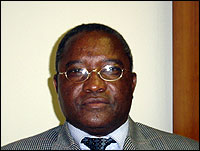
With 22 resorts and camping sites at all the prime tourist attractions across the country. Namibia Wildlife Resorts ’s resorts and camping sites are evenly spread across Namibia. Could you give us your thoughts on the evolution of Namibia Wildlife Resorts activities from its creation to today?
Initially the government owned the twenty-two resorts and camping sites all over the country. These resorts are divided into three subsections spread through all over the entire country. There are those that are wildlife based like the Etosha Pan and the Waterburg Plateau Park. Then there are those that are known for their sceneries like the sand dunes in the Namib Desert. These ones are usually only seasonal. Lastly we have those that are for health reasons like Gross Barmen in Okahandja. Until 1999 the government felt that these resorts should detached from government control and should become commercial entities, but which would still be wholly owned by the government. An organisation was formed with the board of directors selected from their own skills and specialities. They are selected from both the public and the private sectors. Once selected, they have a term of five years from where they can be re-elected. The organisation has an aim to run the institution on an economic basis. The company started very well from 1999 up to 2000. However, from then up to now, it is only about six of the twenty-two resorts that make considerable profits. The problem could probably be brought about by mismanagement and a lack of necessary skills in the human resource management.
Could you tell about some of the Group’s key figures from the last 3 years?
Initially we began with about eight hundred employees, which was too many for an organisation that only runs twenty-two resorts and camping sights. A great impact would also be due to the fact that a great amount of these resorts only operate seasonally. The amount of employees has now declined to about six hundred due unforeseen deaths and retirement within the organisation.
Your vision is to be the leading international recognised resort service provider in prime Namibian locations. What are the competitive advantages you have in front of the other resorts?
Our resorts are truly situated in the best locations in the country. The organisation has to thrive for improvement within its human resource department and try to maintain or improve on the standard of the various facilities.
One of the missions of Namibia Wildlife Resorts is to aggressively build and market it brand both locally, regionally and internationally. What is your strategy to promote yourself around the world ?
There is the strong willingness from the government and the institution itself to make that the country is well marketed. However when there are limiting resources, one cannot diversify wishing. We only now have several offices abroad like in Germany, London, Austria etc. we are now looking for partners to bring about more expertise and exposure to the institution.
The Southern African countries are being seen more and more as countries in which invest in touristic projects. Example of this is the tourism 2006 that will take place in Windhoek and will gather 100 tourism project promoters from Southern African countries and a similar number of potential investors from the European Union and other countries. Would you be interested to participate in one of those projects and if yes in which extend?
We are very interested in seeking investors and during such a conference I believe a lot pf possibilities could be discussed and provide the government with various opportunities to decide upon. The only we issue that we stated in the act of the organisation is that the ownership of fixed assets will remain the property of the government.
What are your expectations in terms of occupancy and revenue?
The revenue and occupancy of our resorts could be improved. So far there are those six resorts that do make considerable profits. Occupancy is essential, like for example, when you go to Etosha the three main resorts are always occupied. In the long run if improvements are brought about, skills are introduced and the human resource divisions are brought up to standard then I believe that occupancy would be up to the maximum in some of the resorts. There is an arrangement between the Namibia Financial Institutions and us to inject quite a huge amount of financial resources for renovations and expansions of resorts, especially those ones that are performing very well. This year we are concentrating on improvement and retraining of staff. We may bring in some minor services, but it is not our major objective.
Your personal experiences are also of interest to us. Could you tell us about your career up to your promotion to Managing Director of Namibia Wildlife Resorts as well as your greatest accomplishment during your time as Managing Director?
Educationally, I have a Bachelor of Arts (Honours) degree in Political Science and International Politics. I also have a Masters in Human Resource Management and another in Business Administration and a third in Public Administration and Public Policy. They were acquired from South Africa and the last two from Australia respectively. I have been Namibia’s first High Commissioner of Charted Affairs to the then USSR. After this I had the similar post but in Nigeria and Malaysia. When I came back home I was transferred to the ministry of environment and tourism where I held the post of deputy permanent secretary.